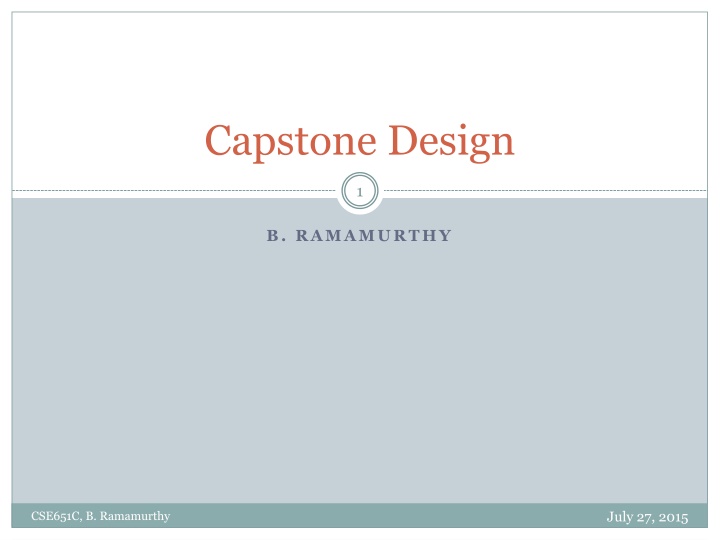
Exploring Capstone Projects in CSE651C by B. Ramamurthy
Discover the significance of Capstone projects as a culmination of knowledge application in CSE651C. Learn about the goals, benefits, and key aspects of Capstone projects, including skill development, project management, and industry perspectives. Explore how Capstone projects enhance design, technical, and soft skills while preparing students for real-world challenges and industry requirements.
Download Presentation

Please find below an Image/Link to download the presentation.
The content on the website is provided AS IS for your information and personal use only. It may not be sold, licensed, or shared on other websites without obtaining consent from the author. If you encounter any issues during the download, it is possible that the publisher has removed the file from their server.
You are allowed to download the files provided on this website for personal or commercial use, subject to the condition that they are used lawfully. All files are the property of their respective owners.
The content on the website is provided AS IS for your information and personal use only. It may not be sold, licensed, or shared on other websites without obtaining consent from the author.
E N D
Presentation Transcript
Capstone Design 1 B. RAMAMURTHY July 27, 2015 CSE651C, B. Ramamurthy
Course Model 2 Emerging Applications Commu nication of research results Capstone Research methods July 27, 2015 CSE651C, B. Ramamurthy
Course Model 3 July 27, 2015 CSE651C, B. Ramamurthy
References 4 J.R. Goldberg. Capstone Design Courses: Producing Industry-Ready Biomedical Engineers, Morgan-Claypool, 2007 July 27, 2015 CSE651C, B. Ramamurthy
What is Capstone? 5 It provides them with the opportunity to apply what students have learned in previous courses; Develop their communication (written, analytical, oral, and graphical (Visualization)), interpersonal (teamwork, conflict management, and negotiation), project management, and design skills; Reinforce the design and development process of a product; It also provides students with an understanding of the economic, financial, legal, and regulatory aspects of the design, development, and commercialization of technology. July 27, 2015 CSE651C, B. Ramamurthy
Why Capstone? 6 Development of design and technical skills Development of soft skills such as teamwork, communication, and interpersonal skills Develop the ability to manage the product development process Oral, written, and graphical/ Visualization communication skills Experience with solving a real-life, open-ended problem Development of an understanding of the industry perspective (including financial, regulatory, and legal issues): in this case automotive industry Exposure to results-oriented evaluations of their projects It is a culmination of all the knowledge from other courses and application of the same. Capstone projects are important components in a program accreditation process (esp. in United States) For your capstone project you can try to use one or more EAPS we will discuss July 27, 2015 CSE651C, B. Ramamurthy
Goal of Capstone Project 7 Ability to design a system, component, or process to meet desired needs within realistic constraints such as economic, environmental, social, political, ethical, health and safety, manufacturability, and sustainability. July 27, 2015 CSE651C, B. Ramamurthy
How do you do it? 8 Define the requirements based on customer/client needs Determine / understand the constraints (e.g. the memory constraint in Arduino boards) Define the problem to be solved Define the project scope Study alternative solutions and compare Make a selection of final design Build prototype to meet needs Validates performance of prototype Document all the steps. July 27, 2015 CSE651C, B. Ramamurthy
Capstone project deliverables 9 Project definition document: contains project objective statement (which defines problem and project scope Requirements document: contains list of needs along with design constraints Generated concepts document: rough sketch or schematic of what you want to do Final concept document: defends selection of proposed final design Experimental validation document: contains test protocols, test results, data analysis, Conclusions regarding how well prototype meets performance requirements Final report: contains final design, test results, information regarding how well the requirements were met Prototype July 27, 2015 CSE651C, B. Ramamurthy
Deliverables Template 10 See the project report we discusses earlier We will prepare a JavaScript-based web page for presenting our project report Multi-media presentation/screen shots/movie clips The paper you will write also helps in achieving the goal of the capstone course. July 27, 2015 CSE651C, B. Ramamurthy
Requirements 11 A clear and well defined requirements-document is important Correctness of design, implementation and testing There are different approaches to specifying the requirements Use case diagram specifies the uses of the system, with user stimulus that invokes a particular use. It also specifies error conditions, and how it is handled. See https://www.andrew.cmu.edu/course/90- 754/umlucdfaq.html It can in a pictorial form or in a text form/document July 27, 2015 CSE651C, B. Ramamurthy
Analysis and Design 12 Typically OO design Class diagrams, sequence diagrams, etc. During the analysis phase you will discover the classes and the relationship (has a, is a, etc) among them. These are represented using class diagrams. The class diagrams are then used as design for the implementation of the prototype. There are other model for analysis and design. You will learn more about these in your OO course. July 27, 2015 CSE651C, B. Ramamurthy
Prototype Implementation 13 In the prototype implementation for this course you will have a hardware and a software component. Clearly document the implementation details and steps taken. An IDE (integrated development environment) will be used in the design of your project. July 27, 2015 CSE651C, B. Ramamurthy
Testing and Modification of Design 14 Your project document should provide the test set used to determine the correctness of your implementation There may functional as well as non-functional requirements that need to be tested. July 27, 2015 CSE651C, B. Ramamurthy
Newer Approaches 15 Probabilistic approaches: many events can be modeled as stochastic or random processes Big data approaches : enormous amount of data is being collected by various sensors inside an automobile, how to analyze this and learn from it, extract useful knowledge, discover anomalies July 27, 2015 CSE651C, B. Ramamurthy
